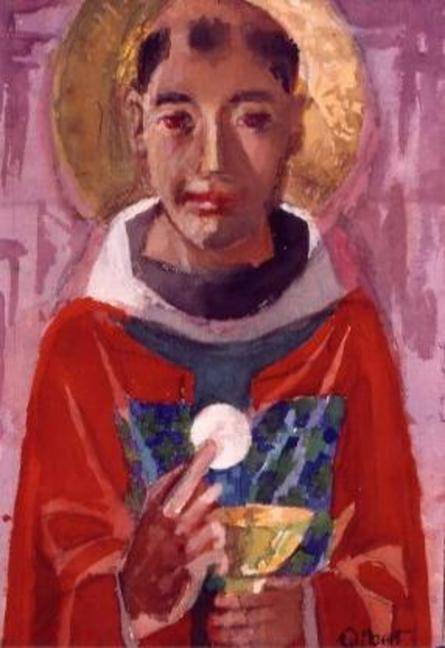John was born in Wales in 1577. Although he was not a Catholic, he was taught by an elderly priest. So, as he said later, he was always a Catholic at heart. John went to Oxford University in England for a while. Even though he was a Protestant, his respect for the Catholic Church prevented him from signing the Oath of Supremacy, which denied the authority of the pope. He had to leave Oxford, so he went to Paris, where, it is reported, upon viewing Notre Dame, he converted to Catholicism.
John lost no time after this in taking steps to become a priest. He went to an English college in Spain and became a Benedictine monk. His great dream of going back to England came true three years later. He and another monk were given permission to set out for that land. They knew the dangers they would meet. In fact, they did not have long to wait before trouble began. They entered England wearing plumed hats and swords at their sides. Soon, however, they were arrested for being priests and sent out of the country.
St. John Roberts went back to London again in 1603 to help the thousands of people who fell victim to the plague. He worked day and night to keep the faith alive during a time when Catholics were persecuted mercilessly. Several times he was captured, put in prison, and exiled, yet he always came back. The last time Father John was arrested, he was just finishing Mass and there would be no escape, having been followed by former priest turned spy John Cecil, who had compiled a dossier on the unfortunate Roberts for James I. He was taken to Newgate prison in his vestments.
When asked, he declared he was a priest and a monk. He explained that he had come to England to work for the salvation of the people. “Were I to live longer,” he added, “I would continue to do what I have been doing.” When he refused to sign the Oath of Supremacy, he was condemned to death.
The night before he was to be hanged, a good Spanish lady arranged for him to be brought into the company of eighteen other prisoners. They were also suffering for their faith. During their supper together, St. John was full of joy. Then he thought perhaps he should not show so much happiness. “Do you think I may be giving bad example by my joy?” he asked his hostess. “No, certainly not,” she replied. “You could not do anything better than to let everyone see the cheerful courage you have as you are about to die for Christ.”
On 5 December he was tried and found guilty under the Act forbidding priests to minister in England, and on 10 December was hanged, drawn, and quartered, at the age of thirty-three, along with Thomas Somers, at Tyburn, London.
It was usual for the prisoner to be disembowelled while still alive, but he was very popular among the poor of London because of the kindness he had shown them during the plague and the large crowd which gathered at his execution would not allow this.
They insisted he be hanged to the death so as not to feel the pain. His heart was then held aloft by the executioner who proclaimed: “Behold the heart of the traitor!” But the angry crowd did not provide the standard response of: “Long live the King!” There was deathly silence.
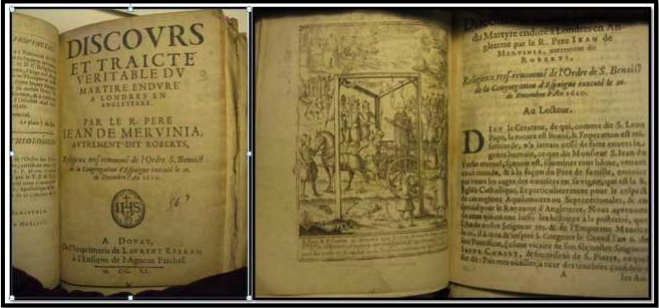
-The Newberry Library of Chicago has undertaken a project to record French pamphlets from the sixteenth to the nineteenth centuries. In the collection of Saint-Sulpice, Paris, Case folio BX4060.A1 S25 ser.1 v. 56 no.3 carries the title which, when translated, shows that it covers the speeches and events associated with the martyrdom of John Roberts. This is “the French life”.
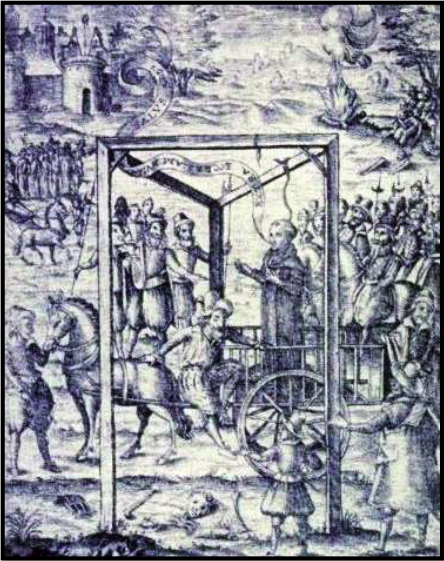
-The 1611 pamphlet from Douai, colloquially “the French life”, transcribed by the Newberry Library contains an illustration of the martyrdom. The image refers to John Roberts of Mervinia and other English monks of the Congregation of St. Benedict in Spain, put to death by heretics in London on 20th December 1610. (Effigies R.P. Joannis de Mervinia alias Roberts monachi Angli congrega. Sti. Bti. in Hispania, ab hereticis interfecti Londini die 20 Decemb. ao. 1610, quod sacerdos et monichiis sedis apostolicae authoritate in Anglia sit missus). In the image we see Roberts about to be hung with the words “Extra ecclesiam nulla salus” (“Outside the church there is no salvation.”) issuing from his mouth. Near the bottom-centre of the image the bones of another martyr are visible, while an execution (dismemberment) is taking place in the upper right-hand side of the image. Similarly, the castle in the distance is depicted with a head on a pike protruding from the tower and below that another monk is bound on a sled behind a horse, presumably being brought to the gallows for execution.
The body of Roberts was recovered by a group that included Maurus Scott and taken to St. Gregory’s, Douai, but disappeared during the French Revolution. An arm was found in the possession of the Spanish royal family before being returned to the Cathedral of Santiago de Compostela, where he had served as a novice. Fingers preserved as relics went to Downside Abbey, to Erdington Abbey, to the Sacred Cross Church in Gellilydan near Robert’s birthplace, to Tyburn convent and to St Joseph’s Convent, Taunton.
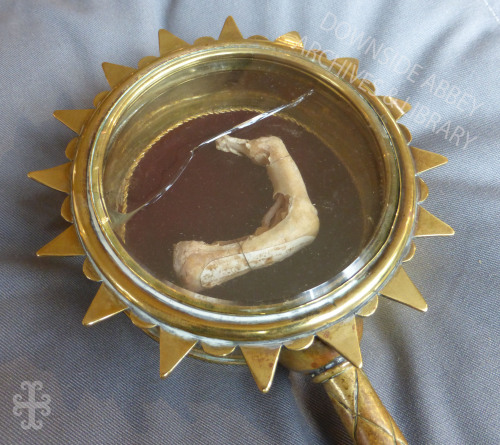
-St John Roberts finger, Downside Abbey Library & Archives
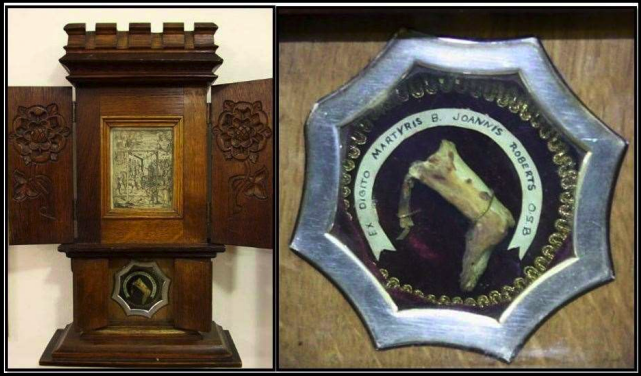
-St John Roberts finger, Tyburn Convent, in a reliquary beneath a depiction of the scene of his execution from “the French life”, as above.
=================
Roman Catholic Bishop Edwin Regan, a currently living Welsh prelate, said: “Although the name St John Roberts, OSB, isn’t as well known today, he is a major figure in our religious history.” He was the first monk to return to Britain following the Protestant Reformation; the hostility between the Catholics and Protestants was at its height at this stage, when a Catholic priest could only expect to live for approximately two years in Britain during that period.”
On 17 July 2010, Metropolitan Seraphim of Glastonbury of the British Orthodox Church, accompanied by Deacon Theodore de Quincey, attended an Ecumenical Service at Westminster Cathedral in celebration of the 400th Anniversary of the Martyrdom of St. John Roberts.
Abba Seraphim noted that as a Londoner he wanted to honor the humanitarian and pastoral ministry of the saint to Londoners; and that all those who are conscious of the problems of exercising Christian ministry in times of persecution would immediately value the saint’s determination as well as realizing the extraordinary sacrifice he made to fulfill his priestly vocation.
Large contingents from Wales were in attendance and the service was bi-lingual. Archbishop of Canterbury Rowan Williams addressed the congregation in both English and Welsh. It was the first time Welsh had been spoken in a ceremony at Westminster Cathedral.
The choral piece, “Beatus Juan de Mervinia” in both Latin and Welsh, was specially commissioned for the service from the Welsh composer Brian Hughes.
Love,
Matthew

